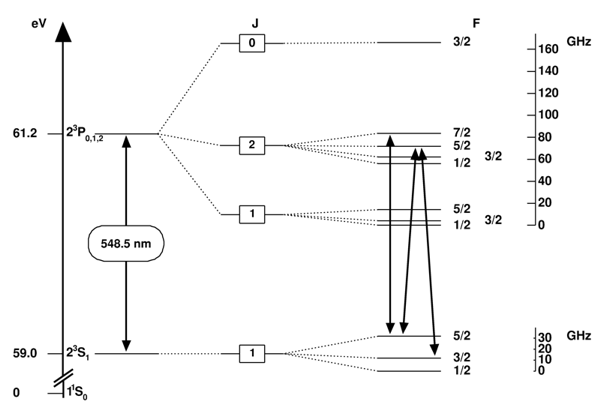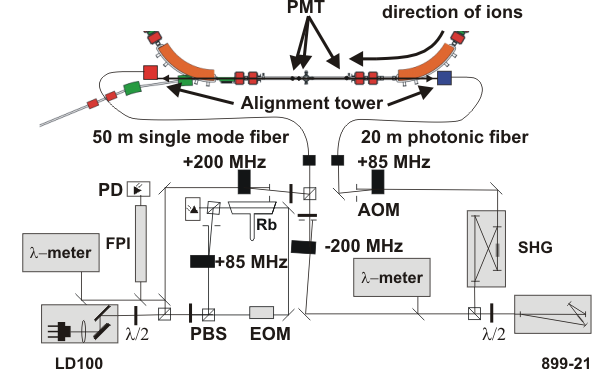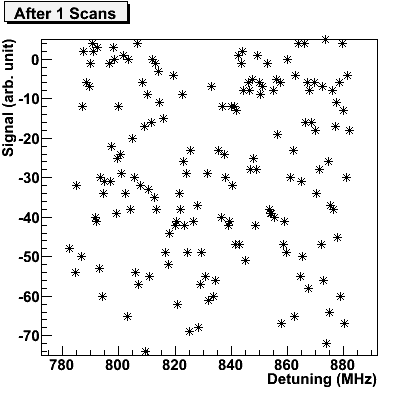

Abstract
There are many open questions in the description of nature like how to combine gravity and quantum mechanics or what is dark matter/dark energy. Also CPT-symmetry and Lorentz-Transformation are under investigation if they are correct. In the following an experiment at GSI is presented as a continuation of a former experiment at MPI for nuclear physics which delivers one of the best test of Lorentz violation. At the experimental storage ring ESR lithium ions are accelerated to a velocity of 34% speed of light and laser spectroscopic methods are used to measure the time dilation and compare it with theory of Special Relativity (SR).
Basics of the experiment
The basic effect of the experiment is the Doppler effect as it is given in Special Relativity. The relation between the frequency  0 in the rest of the moving ion and laser frequency
0 in the rest of the moving ion and laser frequency  l in the lab frame is
l in the lab frame is
 0=
0= l
l (1−
(1− cos(
cos( ))
))
 is the angle between the laser and ion direction.
is the angle between the laser and ion direction.  is the velocity in units of speed of light and
is the velocity in units of speed of light and  is the time dilation factor. In Special Relativity the time dilation factor is given by
is the time dilation factor. In Special Relativity the time dilation factor is given by
 SR=1
SR=1
 1−
1− 2
2
For  =0 or
=0 or  =
= the cosine is
the cosine is  1. The case
1. The case  =0 is called parallel (signed with p) and
=0 is called parallel (signed with p) and  =
= (signed with a) is called antiparallel. Mulitpling these two cases you obtain
(signed with a) is called antiparallel. Mulitpling these two cases you obtain
 0=
0= p
p (1−
(1− )
) 0=
0= a
a (1+
(1+ )
) 
 02=
02= p
p a
a 2(1−
2(1− 2)
2)If  =
= SR it reduces to
SR it reduces to
 02=
02= p
p a
a
To verify the last equation only frequencies must be measured and no velocities must be known. Frequencies can be measured to a high accuarcy.
For comparision of different experiments the last relation can be written as (s. Testtheories)
 02
02 p
p a=1+2
a=1+2
 2
2Results from earlier storage ring experiments
At the storage ring TSR in Heidelberg laser spectroscopy with ions at 3 percent and 6.4 percent speed of light were carried out. As transition a closed two level system of the metastable triplet and saturation spectroscopy was used. The transition wavelength is 548 nm. At 3% the parallel laser was a solid state laser at 532 nm and as parallel laser a dye laser at 565 nm was used. The laser for 6.4% were a dye laser at 585 nm and an argon ion laser 514 nm. An complete describtion of the experiment is given in the PhD thesis of Sascha Reinhardt. The final results are published in {[literatur.bib,SaschaReinhardtNaturePhysics2007]}:
 =(−4
=(−4 8
8 8
8 4)
4) 10−8
10−8and for the transition frequency  0 (if Special Relativity is ok)
0 (if Special Relativity is ok)
 0=(546 466 918 531
0=(546 466 918 531 73) kHz.
73) kHz.Illustration how the ions are accelerated to 0.34c at GSI
At GSI the lithium ions 7Li+ are produced in an ECR ion source and is mainly accelerated by a linear accelerator (UNILAC) and a synchrotron (SIS). The final velocity is 0.338c or a kinetic energy of 409 MeV. The ions are stored in the experimental storage ring ESR and prepared for the laser spectroscopy.
Laser spectroscopy at ESR
For the laser spectroscopy at ESR the  -system of the lithium ion is used.
-system of the lithium ion is used.

To excite this transition the parallel laser has wavelength of 386 nm and the antiparallel laser has a wavelength of 780 nm. The antiparallel laser can be realized by a laser diode and the parallel laser by a frequency doubled of a titanium sapphire laser. The overlap between the laser beams and the ion beam is done by mechanical apperaturs and the fluorescens is detected by photomultipliers distributed over the interaction region.

Setup ESR experiment for beamtime August 2007

Example for a saturation signal with Li ions at 6.4%c